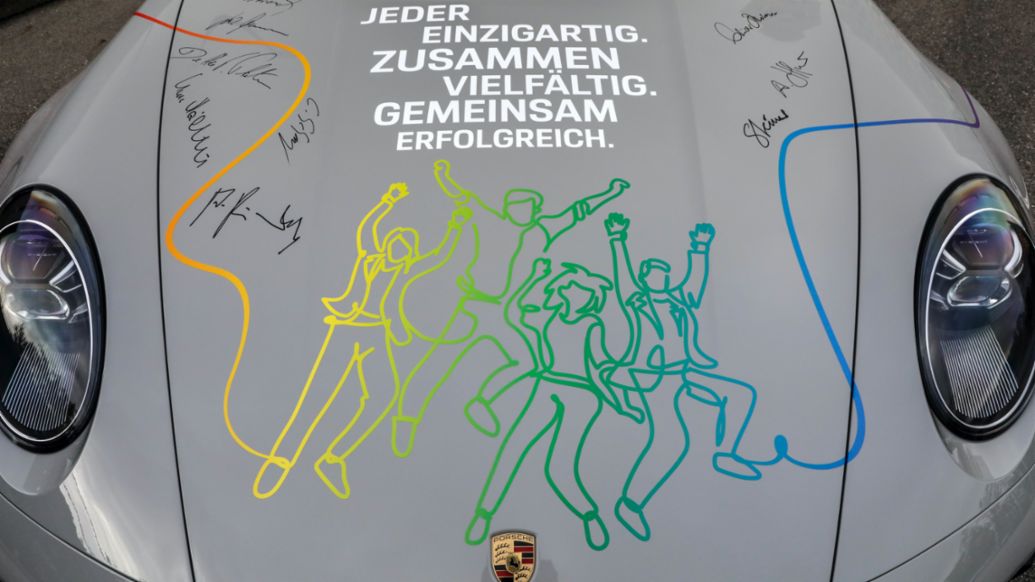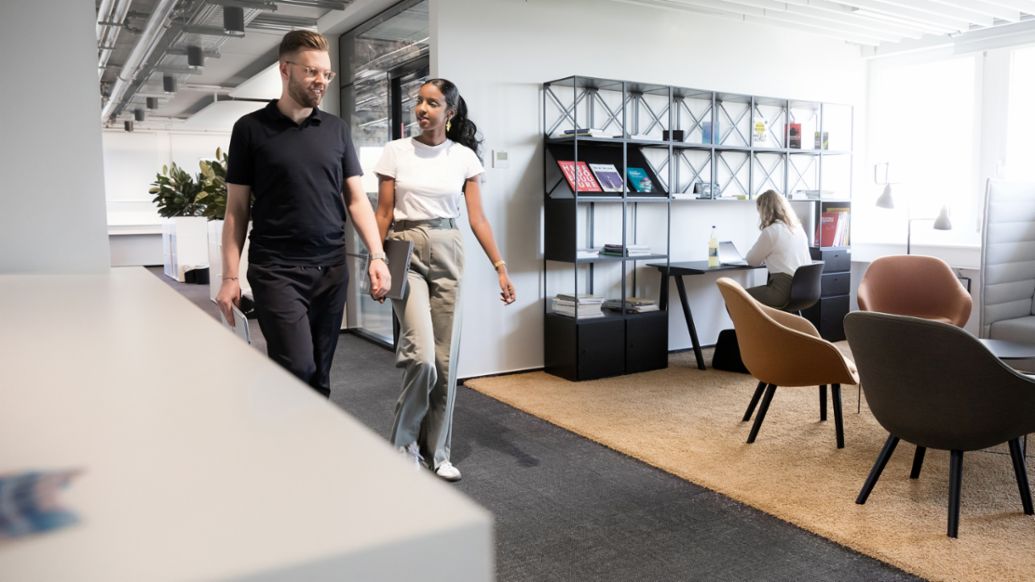Porsche actively champions diversity and equal opportunities, and firmly believes that this also serves its interests as a company. Diversity of views leads to new ideas and drives innovation, which makes it a key success factor. Active diversity management creates a better understanding of the market and leads to greater employer attractiveness.
Inclusion of stakeholders and society
Porsche involves internal and external stakeholders in its activities relating to diversity and equal opportunities. It is for this reason that the company has internal committees, such as the Equal Opportunities working group and the Porsche Sustainability Council, and maintains a dialogue with representatives of subsidiaries, such as in the context of the International Diversity Community.
Porsche promotes diversity and inclusion outside of the factory gates too. The company supports social projects and finds voluntary placements for employees. Its voluntary engagement serves society and broadens people’s horizons. Porsche seeks a dialogue with non-governmental organizations, for example, for this very purpose.
Diversity as a corporate principle

Safeguarding and promoting diversity and equal opportunity are hugely important to Porsche. The company rejects all forms of discrimination. It wants to establish a tolerant, inclusive culture that promotes diversity of views and appreciates people’s differences. All employees should be able to contribute their personalities and develop their personal potential. This results in a high level of productivity, competitiveness, innovative capacity, creativity, and efficiency.
At the same time, Porsche wants to bolster its employees’ sense of belonging and communal spirit. As an integral part of its corporate culture, diversity shapes the cultural self-image of the “Porsche family”. It perceives employees’ differences in terms of gender, nationality, ethnic background, religion, disability, age, sexual orientation and identity, and other protected characteristics as an advantage and a competitive factor for Porsche.
Porsche has enshrined diversity as a corporate principle and signaled this to the general public: the Executive Board and Works Council signed a voluntary undertaking known as the “Charta der Vielfalt” (Diversity Charter) in 2019. In 2022, the Executive Board and top management renewed their commitment to these values by signing the Porsche Diversity 911: this display vehicle is decorated with lots of messages and facts relating to “Diversity@Porsche”.
The Culture, Diversity, and HR Communication department has been tasked with implementing and safeguarding these values at Porsche on a long-term basis. It serves as a trailblazer and expert partner and is part of the Employee Development and Corporate Culture division.
Equal opportunities and the promotion of diversity are enshrined in the Code of Conduct and the “Porsche Code” management mission statement.
Porsche has set itself the goal of further increasing diversity within the company by 2030. To this end, Porsche is promoting collaboration in mixed teams with a variety of different views. This is driven by a way of thinking that encourages diversity and an awareness of the positive effects and complexity of diversity.
As a criterion for diversity through mixed teams, Porsche has set itself the goal to reach a proportion of women of 20 % on the first management level and 18 % on the second management level by 2025, based on the gender quota required by law.
Protection against infringements
Porsche has a whistleblower system in place via which possible violations of equal opportunity and equal treatment can be reported. With this system, Porsche can take a standardized approach to investigating possible violations of the rules, taking into account data protection, labor law, and co-determination requirements. If violations are identified, action is taken accordingly.
Furthermore, Porsche has set up a company complaints desk known as “AGG” (the German abbreviation for the General Equal Treatment Act) to which employees can turn in potential cases of discrimination or to which they can submit a specific complaint.
Porsche was not aware of any instances of discrimination in 2022. There were six cases of sexual harassment, each of which resulted in disciplinary action in the form of a warning. No structural relationship was evident.
Gender pay gap analysis

Porsche takes diversity and equal opportunities very seriously and pays wages and salaries in line with uniform standards, regardless of gender, religion, origin, age, disability, or sexual orientation.
For employees covered by a collective bargaining agreement and management within and outside of the collective bargaining agreement, the remuneration policies and amounts are based on collective/company regulations, whereby the basic remuneration is calculated on the basis of described work tasks, with consideration for knowledge and abilities, problem-solving skills, potential influence, and fields of responsibility. The variable remuneration is performance-based as a rule. The amount of variable remuneration is calculated on the basis of general or individual performance criteria as well as selected KPIs, according to uniform benchmarks and standards. Collective and company regulations also provide for one-off payments. Market-specific particularities and benchmarks are also taken into account for the purposes of offering competitive remuneration.
The goal is to provide employees with attractive, competitive, and non-discriminatory remuneration while identifying and eliminating alleged injustices.
For data availability reasons, only data relating to Porschewill be used in subsequent evaluations. Of the 20,803 employees being taken into consideration in this way (excluding part-time retirees), 3,139 are women (15 %) and 17,664 are men (85 %).
Looking at the bigger picture, a comparison of the average remuneration of all women with the average remuneration of all men reveals a 5.5 % difference in basic annual remuneration and a 0.4 % difference in direct remuneration in the favor of women.
In particular, this difference is due to the distribution of men and women across the various hierarchical levels, with 52 % of all employed men being in the lower collectively agreed pay scales (including incentive wage earners), compared to just 24 % for women. Consequently, the average remuneration for all men is lower than the average for all women.
With regard to non-union employees, there is a difference of –2.5 % for the basic annual remuneration and of –1.8 % for direct remuneration to the detriment of women.
This is because the proportion of non-union women is gradually declining as the pay scale rises.
With regard to employees covered by a collective agreement, there is a difference of 9.9 % for the basic annual remuneration and of 5.0 % for direct remuneration in favor of women.
Essentially, just like the overall evaluation, this effect is due to the distribution of men and women within the individual collectively agreed pay scales
Gender pay gap analysis by age categories
The total population at Porsche falls into the following age categories:
The age distribution across the total population shows that two-thirds of all men and women fall into the 30–50 years category. Additionally, there is a relatively high proportion of women in the < 30 years category (22 %). There is a higher relative proportion of men in the > 50 years category (15 %).
The remuneration assessment by age categories shows that women in the < 30 years category and 30-50 years age categories earn more money on average. In the > 50 years category, the average remuneration of men is higher than for women.
The aforementioned distribution of men and women across the various salary groups is particularly evident in the < 30 years age category, as the proportion of young men in lower-paying salary groups is even higher by comparison.
Overall, men earn more on average in the > 50 years age category, in a complete reversal of the effect. In this category, the proportion of men in higher-paying salary groups is significantly higher than for women. As such, the average remuneration for all men is higher.
Furthermore, the remuneration of the entire Porsche workforce is subjected to a differentiation analysis on a regular basis. Descriptive and econometric methods are used to identify potential needs for action.

